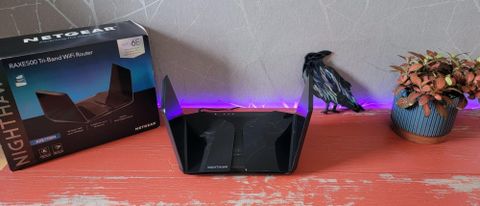Tom's Hardware Verdict
Netgear RAXE500 looks good on paper and in person. But our testing shows it has major prioritization problems on congested networks. And router-level security costs extra, despite the router’s very high price.
Pros
- +
+ Tri-band, with 6 GHz speed
- +
+ Easy antenna deployment
- +
+ Strong 5 GHz throughput tests
- +
+ Supports link aggregation
Cons
- -
High price
- -
Lacks QoS
- -
Security costs extra
- -
Bumpy setup
Why you can trust Tom's Hardware
The Netgear RAXE500 is an early entry into the Wi-Fi 6E router space, and on paper at least, it looks like a wireless network powerhouse. It also looks good and is easy to set up--at least on the hardware side--with no antennas to attach. But as we’ll see in testing, it struggles a lot on a congested network. And despite it’s very high price, Netgear charges extra for ongoing security support.
But before we jump deep into the router’s details, a quick cutting-edge Wi-Fi primer: While it may seem like Wi-Fi 6 (802.11ax) is still new, Wi-Fi 6E is the latest generation of standards to feed our wireless data needs. The names of these standards can certainly get confusing, in part because Wi-Fi 6E also gets designated as 802.11ax. However, 6E has even faster potential speeds on the 5 GHz frequency. The big change, though, is an entirely new frequency -- 6 GHz -- which should be a lot less crowded, at least until all of your neighbors upgrade their gear as well. But don’t expect any of your existing tech got get much benefit from 6E. Until you upgrade to Wi-Fi 6E on the device side, you won’t be able to take advantage of these advancements. Check out our feature for much more on the differences between Wi-Fi 6 and 6E.
Design of the Netgear RAXE500


The Netgear RAXE500’s body is made of solid black plastic, that’s simple to deploy because there are no antennas to screw onto the body. The hardware setup is as simple as unfolding the two wings--the design certainly saves time and effort. The overall aesthetic appears somewhere between an Imperial TIE fighter and an ocean-dwelling manta ray. In case you’re worried about quantity affecting performance, the wings hide a total of 8 antennas inside.
The router’s size isn’t the biggest we’ve seen, but is by no means small. At 11.7 x 3.07 x 8.3 in (298 x 78 x 211 mm) and weighing 3.2 lb (1.45 kg), the Netgear RAXE500 feels substantive, without being overly bulky.

The back of the router includes four Gigabit Ethernet LAN ports, along with a WAN Gigabit Ethernet port, and a 2.5G Multi-Gig port. The Netgear RAXE500 also supports link aggregation of the Gigabit ports, for even faster speeds. For adding network-accessible storage, there are also a pair of USB 3.0 ports.
Specifications of the Netgear RAXE500
Under its plastic shell, the RAXE500 houses a 1.8 GHz quad core processor with 512MB NAND flash and 1GB of DDR3 SDRAM. With its formidable hardware and support for Wi-Fi 6E, the router sports some impressive speed specs. We are talking about 2.4 GHz up to 1.2 Gbps, 5 GHz up to 4.8 Gbps, and 6 GHz up to 4.8 Mbps, for a total theoretical bandwidth of 10.8 Gbps. This makes it a Tri-band router, with three distinct frequencies.
Netgear’s RAXE500 also includes some of the lesser-known latest wireless technologies, such as support for 1024-QAM ( which has better 25% data efficiency and faster speeds than 256-QAM routers), additional DFS channels to reduce interference, support for WPA3, and 4X4 MU-MIMO.
Setup of the Netgear RAXE500
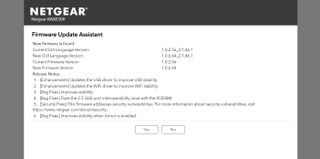
Setup of this router could certainly have gone smoother. We chose to us the browser, but there is also an option for installing and using a smartphone app.
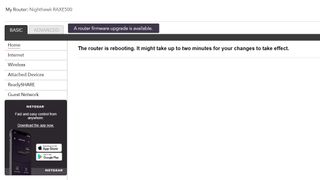
Things started out well, as the router informed us on initial setup of a firmware update and began downloading it. We were then informed that the upgrade was complete after waiting a few minutes on the setup screen. However, when we went back into the router software, the firmware was in fact on the same version number as when we started. We had to trigger it manually and wait all over again for the upgrade process. This would be really easy to miss if you were a novice, or just not paying close attention. For a router in this price category, we’d expect much better. That’s a feeling we’ll come back to shortly.
Security
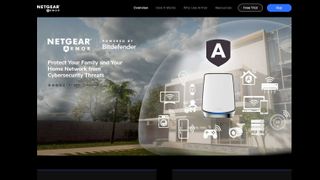
The RAXE500 does have security, but we were disappointed that it comes at an additional charge, despite claims that it is “built in” to the router. After a 30-day trial period, it is a $69.99 annual fee. The software can work on the network level via the router to scan all traffic and keep it secure. However, some competitors, especially on higher end gear, offer security without an additional payment. That said, users who do pay up get not just Bitdefender Security, but also Bitdefender VPN, so if you were going to pay for a VPN anyway, the price is quite fair.
Performance of the Netgear RAXE500
| Header Cell - Column 0 | 2.4 GHz near | 2.4 GHz far | 5 GHz near | 5 GHz far |
|---|---|---|---|---|
| Bandwidth (Mbps) | 210.3 | 160.1 | 1398.5 | 951.8 |
| Phone test (download/upload) | 168/36.7 | 172/36.7 | 341/36.8 | 325/35.6 |
We put the RAXE500 through the usual battery of tests, starting with looking at throughput. Testing is done with an Asus gaming laptop, with an Intel WiFi 6 AX201 card. Unfortunately it does not support WiFi 6E, so we cannot test performance on the 6 GHz frequency. The 2.4 GHz speed was a solid 210.3 Mbps on the near test, and dropped to 160.1 Mbps on the far test. The 5 GHz test was more impressive, with a 1398.5 Mbps close test, and a drop to 951.8 Mbps on the far test.
To overcome the lack of a WiFi 6E card on our laptop, we tested further with Samsung’s flagship Galaxy S21 Ultra 5g. This was performed using the SpeedTest app that can measure both on the upload and download side of the speed equation. While it confirmed the fast throughput of this router, on the 5 GHz frequency, we easily maxed out on both the upload and download side, as our internet connection is officially a 300/35 connection, which is typically mildly overprovisioned to ensure bandwidth. This explains the speeds we obtained of 341 Mbps download and 36.8 Mbps upload using 6E on the test phone.
| Testing Configuration | QoS | FRAPS avg | min | max | 8k dropped frames | Pingplotter spikes | Latency (Overwatch) |
|---|---|---|---|---|---|---|---|
| Ethernet | no | 142.83 | 119 | 184 | n/a | 0 | 68 |
| Ethernet + 10 8k videos | no | 21.88 | 0 | 83 | 42.20% | 16 | 288 |
| 5 GHz | no | 121.15 | 101 | 158 | n/a | 0 | 183 |
| 5 GHz + 10 8k videos | no | 13.28 | 0 | 44 | 37.20% | 2 | 243 |
| 2.4 GHz | no | 112.55 | 106 | 118 | n/a | 0 | 187 |
| 2.4 GHz + 10 8k videos | no | 31.68 | 0 | 110 | 39.20% | 12 | 123 |
The network congestion testing showed that the RAX500 could really benefit from implementation of robust Quality of Service (QoS), which allows a router to prioritize traffic to smooth out gameplay, and allow a video to play smoothly.
When this router is in an uncongested environment, for example, when connected via Ethernet with no background videos, our game of Overwatch achieved a respectable 142.83 FPS, with no Pingplotter spikes (which signify dropouts). We also had an in-game latency of 68 millisecs in Overwatch.
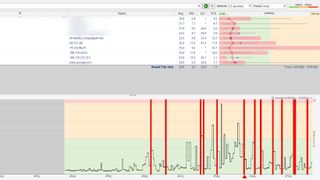
However, add in the congestion, in our case ten 8K YouTube videos, which saturate our Optimum Online cable connection, and the game’s FPS precipitously drops to 21.88 FPS, and even went down to 0 FPS during gameplay-- essentially becoming a frozen game. Confirming the congested situation, the PingPlotter spikes went to a very high sixteen during our short gameplay session, and the dropped frame rate on the 8K videos was at a high 37.2%.
An analogous situation was created each time for both the 2.4 GHz and 5 GHz wireless frequencies with a minimum FPS of zero, and high dropped frame rates on the 8K videos.
We ended up with a situation where the raw throughput was impressive, but the congestion testing revealed a significant drop in performance. Of course, we wondered if there wasn’t an issue with this particular router (be it in the hardware or firmware). But after getting our hands on a second version of the Netgear RAXE500, things didn’t really improve. \
We set it up once again, including updating to the latest firmware version, and putting it through another round of testing to verify. With the lack of QoS, we once again replicated the results, with the game freezing on both the 2.4 GHz and 5 GHz network congestion tests, and this time both with over 50% of the frames dropping on the 8K videos. Ouch.
Bottom Line
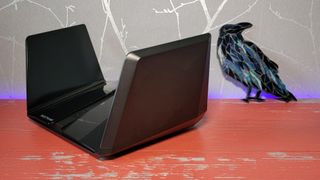
We expected better performance from the RAXE500, and that was before we factored in the price. While it’s of course true that ongoing Covid-19-related issues have inflated the price of many products, the $599 MSRP and $529 street price of the RAXE500 puts it solidly at the high end of the high end category of consumer routers. Early adopters often overpay for the privilege of bragging rights. But in this case you’d be paying more than double the price of a solid midrange router, mostly for the privilege of being able to tell your friends and relatives that you have a 6 GHz wireless network.
Even if that’s important to you, keep in mind that even Wi-Fi 6 devices won’t connect on the 6 GHz frequency unless they specifically support Wi-Fi 6E. At the moment, such devices are few and far between, largely including recent high-end phones. So you probably won’t make much use of that 6E network, as most of your devices will still be stuck on the 5 GHz band. Making matters worse, for such an expensive router, the RAXE500 is missing some features that we’d consider fairly basic in a high-end router, like QoS for better traffic control, and included security without an additional yearly fee.
Overall, the Netgear RAXE500 is a bleeding edge product that feels like it needs more work. Perhaps it was rushed to market, but it simply lacks the high-end performance that a router at this level should deliver. For now, it is a glimpse into the promise of the next generation of Wi-Fi 6E wireless, with high throughput scores, but that promis proved hollow when we tested performance in a crowded environment. We don’t recommend purchasing this router based on our results, but we can’t wait to see how the next wave of WiFi 6E routers will perform, companies get past these 6E teething pains.

Jonas P. DeMuro is a freelance reviewer covering wireless networking hardware.

Portable AI supercomputer comes as a carry-on suitcase with wheels — four GPUs, 246TB of storage, and a 2,500W integrated power supply

Asus quotes ridiculous $2,750 fee to replace chipped GPU power connector— docs back up claims of egregious repair pricing for $2,000 RTX 4090 GPU

Vendor releases an Intel motherboard for Anime fans — iCraft B760M Cross comes decked out with pastel colors
